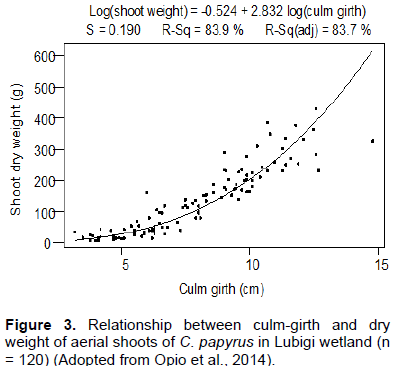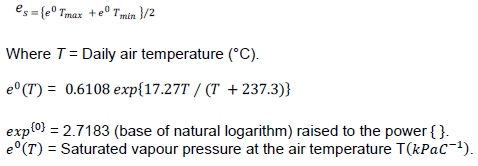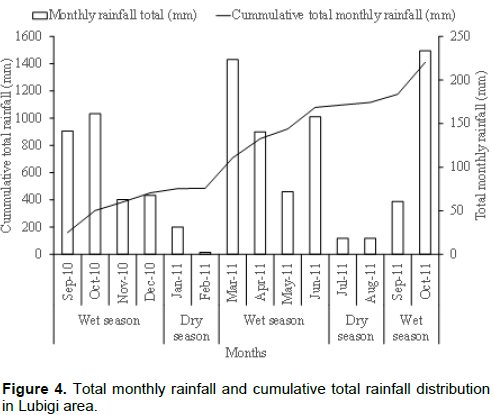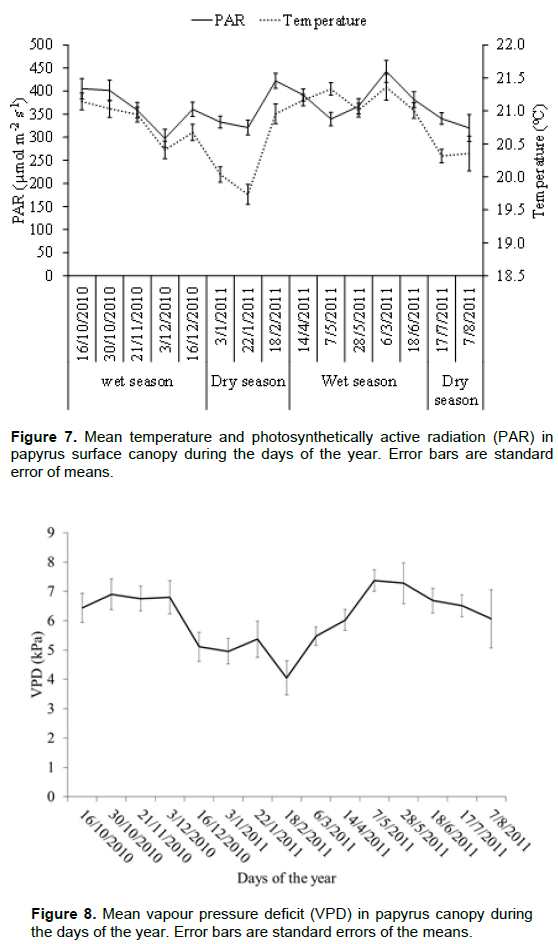ABSTRACT
Ecosystem development is related to climatic conditions. To assess the effect of seasonal changes in climate factors on papyrus ecosystem development, community biomass was estimated non-destructively and climate factors recorded in the wetland. Absolute aerial biomass and productivity were not significantly different between wet and dry seasons. Although there was significant vapour pressure deficit change over the seasons, the impact on net primary productivity was not significant, but exhibited positive association during dry season. Primary productivity was positively related to photosynthetically active radiation during both dry and wet seasons. Except for the dry season that accounted for 26.1% of primary productivity, that of the wet season was independent (0%) of measured weather variables.
Key words: Cyperus papyrus, photosynthetically active radiation, productivity, relative humidity, temperature, wetlands.
Although photosynthesis is fundamental to plant growth and estimated as net biomass accumulation, other environmental factors modify its magnitude (Hall and Long, 1993; Page et al., 2011). The understanding of how environmental changes influence plant growth is critical for the assessment of potential impacts of climate
change on ecosystems.
Weather variability measured as changes in rainfall, temperature, solar radiation, humidity and wind characteristics interact with plant and influence processes such as photosynthesis, respiration, transpiration and translocation (Beadle, 1993; Jones, 1993). Changes in weather variables (rainfall pattern, wind speed, temperature and evaporation rate) during the year in Lake Victoria basin in East Africa region has been reported (Hughes and Hughes, 1992; Spigel and Coulter, 1996; Yin et al., 2000; Oyugi, 2010).
Knowledge of the effects of such changes are necessary for improving the accuracy of global climate carbon models within the region, and also provide support to the program of improving wetland management and policy for climate change mitigation and carbon accounting. The new policy to reduce greenhouse gas emission through reforestation in developing countries have highlighted the prospects of conserving tropical wetlands by negotiating carbon offset and trading agreements (Murdiyarso et al., 2010). This study investigated the contribution made by tropical papyrus wetlands to carbon stock.
The influence of weather variability on Cyperus papyrus ecosystem productivity is yet unclear. However, modeling results of micro-climate and light interception on C. papyrus bracteole (leaf) photosynthesis was done (Jones, 1988; Humphries and Long, 1995). Model prediction and productivity measurements suggest that increasing temperatures may result in substantial decrease in carbon sequestration and inputs to stored carbon in the underlying papyrus peat deposits (Humphries and Long, 1995; Saunders et al., 2007).
Saunders et al. (2007) estimated the carbon sequestration of tropical papyrus wetlands from measurement of net ecosystem exchange by eddy covariance. Maximum rates of CO2 assimilation were associated with peaks in both air temperature and photosynthetically active radiation (PAR) flux with lesser vapour pressure deficit (VPD) effect. The study involved analysis of diurnal CO2 flux produced from the wetland as a result of decomposition, respiratory growth and maintenance respiration.
Temperature influence and other weather factors that directly or indirectly influence papyrus productivity measured as absolute biomass change has not been fully investigated. The standing biomass is important because individual dying shoots in papyrus wetlands are replaced through recruitment. This takes care of the population dynamics within wetland systems, and provides empirical data for biomass quantification that can be used to upscale to larger wetland area using accurate papyrus area estimation by satellite imagery (Maclean et al., 2006).
In this study, it is hypothesized that weather factors drive pattern of papyrus development. Although the quality and quantity of stream inflows into and out of wetlands, macrophyte harvesting and characteristics human settlement around the wetland would have influence through nutrients input into the wetland systems that would ultimately influence productivity and its variability, they were considered as integral constant factor in this model.
Study area
The study was conducted in Lubigi wetland, a monotypic C. papyrus wetland in Kampala District, Uganda. The wetland covers total area of 2.96 km2 (Namakambo, 2000). Daily average temperature of the area ranges between 17 to 27°C during the year. This is a typical tropical wetland conditions, characterized with wet and dry climate. Rainy seasons are from September to December and March to May of each year. Erratic changes have been observed in the onset and end of the different seasons in the recent past.
Site selection for the metallic tower in the study area
The selection of the site for mounting the metallic tower was in the monotypic stand of papyrus plants located about 170 m from the wetland edge. The bottom sediment of the location was approximately 4.5 m deep. The tower was used for the attachment of meteorological unit (Figure 1). The meteorological unit was located at approximate 1,165 m above sea level at 0°24´ N and 32°31´ E. Further anchorage of the tower in the papyrus mat was done by forcing longer pieces of timber across the width of rectangular frame that rested on the papyrus mat. This gave the tower structural firmness on the papyrus mat in order to support additional weight. A ladder walk way (transect) was constructed in the wetland using eucalyptus poles to allow easy movement into and out of the wetland (Figure 2).
Papyrus biomass and primary productivity assessment
Biomass and primary productivity assessments were done in quadrats (3 x 3 m2), and limited to the aerial growth of the monotypic stand of papyrus. The assumption was that growth in papyrus wetlands only occur as turnover rate of the aerial shoots for fully developed rhizome structures. Eight replicate quadrats located along the access transect at distance of 100 m were used for the investigation. Each quadrat was 2 m away from the center line of the transect. All live culms within the quadrats were identified and culms girth measured during each visit. The assessment covered eleven months (October, 2010 to August, 2011) at intervals of three (3) weeks. Live culms whose girth were measured included those with un-opened umbels, partially open and fully open green umbels without signs of senescence (< 40% of the umbel brown and no clear evidence of senescence). The regression equation 1 of biomass (y) against culm sizes (girth) (x) was used (Figure 3) to estimate C. papyrus biomass after measurements of culm-girth of different papyrus population, and life cycle within the quadrats. Productivity was computed from biomass difference between sampling intervals divided by number of days in each interval. Biomass and productivity values were reported per unit area.

Weather factors in the surface of C. papyrus wetland canopy
Temperature and relative humidity (RH) in the surface of C. papyrus wetland canopy were monitored using inbuilt sensors in the Skye Data Hog 2 logger, type SDL 5260 and changes in photosynthetically active radiation (PAR) was recorded using SKP 215/S/D/I 36961 pyranometer. These were used as indicators of critical weather factors. All weather variables (values) were averaged on 30 min interval from October, 2010 to August 2011. The stored weather data was regularly downloaded to a lap top computer using Skye software after every two weeks interval. The vapour pressure deficit (VPD) in papyrus canopy was calculated based on formula of FAO (1998). Minimum and maximum values of temperature and RH were used in the calculations to avoid lower estimation of mean saturation vapour pressure. A standard value for the atmospheric pressure and psychrometric constant as a function of altitude was used.
Mean saturated vapour pressure of the air
Saturated vapour pressure is related to air temperature and was calculated from the air temperature;
Actual vapour pressure derived from relative humidity data of the air
Relative humidity (RH) was expressed as the degree of saturation of the air as a ratio of the actual to the saturated vapour pressure at the same temperature It constituted the ratio between the actual amount of water, the ambient air had and that it could hold at the same temperature. Although the actual vapour pressure was considered relatively constant throughout the day, the relative humidity was considered a maximum near sunrise and minimum around early afternoon. Therefore, the calculation of vapour pressure was based on the mean RH data.
Where
Data analysis
Statistical analysis was done using Minitab software, Release 13 for windows. Non-parametric Kruskal-Wallis test was used to assess differences of biomass, productivity and weather values between dry and wet season. Multiple regression analysis was done to assess the relationship between independent variables (RH, temperature, PAR) and the dependent variable (productivity). Homogeneity of variance in data sets during the multiple regression analysis was automatically tested by Durbin - Watson statistics to ensure uniformity. All statistical values were considered significant at less than 0.05.
Monthly total and cumulative total rainfall distribution
The monthly total rainfall and cumulative distribution showed longer wet season compared to the dry seasons (Figure 4). The percentage rainfall in the dry season was below 50% of the minimal monthly rainfall during the wet season.
Papyrus aerial standing biomass and primary productivity (NPP) in Lubigi wetland
Biomass range was 1.80 to 6.69 kg m-2 and 3.43 to 6.76 kg m-2 during wet and dry season respectively (Figure 5). Kruskal-Wallis test of seasonal biomass differences was not significant (H = 31.15, DF = 15, p = 0.983). The increased trend of papyrus biomass up to February 2011 indicated a recovering ecosystem which is attributed to the effect of past massive papyrus harvesting. During the establishment of the quadrats, the papyrus culms appeared well established. NPP were not significantly different between the seasons with mean values of 28.96±3.99 g m-2 d-1 and 25.99±6.35 g m-2 d-1 during wet and dry seasons respectively. NPP changes coincided with the months of biomass changes. The high variability during May, 2011 and August, 2011 (Figure 6) is attributed to some of the experimental quadrats that were covered by a climber, Ipomoae purpurea. The climber emerged in the wetland during the investigation period. The variability could also be related to the effect of the strong flow regime that disturbed the quadrats. Kruskal-Wallis test of NPP during the days of the year was not significant (H = 22.37, DF = 15, p = 0.099) except for the wet season from October, 2010 to December, 2010, and the dry months of February, 2011 and July, 2011 that were above the critical value (H) of 22.37 g m-2 d-1 which corresponded to the significance level.
Weather changes in Cyperus papyrus surface canopy
Temperature pattern was similar to PAR (Figure 7), and had higher range during wet season (12.7 to 30.6°C) compared to the dry season (11.2 to 31.1°C). Temperature changes were not significantly different since all values were below the critical value (H) (H = 61.18, DF = 1, p = 0.00) that corresponded to the significance level. Diurnal PAR range was 0 to 2332.6 µmol m-2 s-1 and 0 to 2031.6 µmol m-2 s-1 during wet and dry season respectively. Highest PAR coincided with the months of September and March. Although mean PAR was higher during the dry season, comparison of means indicated non-significant difference between seasons (H = 0.54, DF = 1, p = 0.464). VPD decreased to minimum values in the dry season, and increased to maximum values during the wet season (Figure 8). Seasonal comparison of VPD indicated significant difference during the days of the year (p = 0.037).
Relationship of aerial papyrus productivity with VPD, temperature and PAR
The overall relationship between weather variables and productivity was not significant during both dry and wet seasons (p = 0.409 and p = 0.882 respectively) (Table 1). The seasonal regression models for the relationships were:
NPP (dry season) = 0.34PAR + 1.24VPD – 1.39 Temperature + 17.2
NPP (wet season) = 0.01PAR -3.3VPD – 1.75 Temperature + 69.7
Overall, weather variables explained productivity variance by 26.1% during the dry season, and that of the wet season was independent of the weather variables (0%).
The estimated NPP in Lubigi wetland were within the range reported by many authors (Thompson et al., 1979; Muthuri et al., 1989; Jones and Muthuri, 1997; Boar, 2006; Bakari et al., 2007). The non-significant difference in seasonal NPP conforms to the study by Muthuri et al. (1989) in Naviasha wetland, Kenya. However, NPP values were slightly higher than 22.1 g m-2 d-1 (Saunders et al., 2007) and 21 g m-2 d-1 (Muthuri et al., 1989). The variability of 3.40 to 64.42 g m-2 d-1 and 3.12 to 74.65 g m- 2 d-1 during wet and dry seasons respectively were broader compared to 24.7 to 34.1 g m-2 d-1 range (Muthuri et al., 1989). Productivity differences in papyrus wetlands are attributed to structural differences which affect the amount of carbon that can be assimilated by the plant community (Jones, 1988). Beadle (1993) reported older or more complex community normally exhibit decreased productivity.
Mitsch and Jørgensen (1989) reported development of plants as a function of initial conditions and the strength of the conditions on the plants. The effects of dead biomass accumulation, high senescence and culm production contribution to the lowering of NPP have been investigated in plant (Leoni et al., 2009). Therefore, natural regeneration capacity in papyrus wetlands contributes to structural changes with effect on growth (Bakari et al., 2007). This is because papyrus wetlands exhibit establishment, growth and mortality concurrently (Muthuri et al., 1989), which imply a balanced trade-off of resources characteristic of tropical environment. However, environmental factors have been reported to affect magnitude of growth, shift carbon allocation, change productivity and shift mode of reproduction (Hunt, 1982; Beadle, 1993; Fennessy et al., 1994; Jones, 1993). Coletti et al. (2012) indicated that short term and long term vegetation responses may also be counter-intuitive due to adaptability in water uptake strategy of the vegetation community partially decoupling biomass from water availability. Lowest ratios of measured transpiration and photosynthesis in plants in the middle of dry season at a time when stomata responded strongly during optimum of photosynthesis at high temperatures were reported (Schulze et al., 1975). Therefore, the feedback mechanism in carbon sequestration involves synergy of processes, where an initial process triggers changes in a second process that in turn influences the initial process. A positive feedback intensifies the original process, and a negative feedback reduces it.
In papyrus dominated wetlands, changes in seasonal growth were thought to occur independent of relatively constant weather parameters (Saunders et al., 2007). In this study, although the variation of VPD was significant over the period; the relationship with productivity was not significant. High NPP was associated with increased PAR during both seasons. Increasing VPD reduced NPP during the wet season but was associated with the rising NPP during the dry season. Overall, impact variance of weather variables on NPP was zero during the wet season; imply productivity change is caused by other environmental factors. These include nutrient concentrations that were reported to increase papyrus growth (Kansiime et al., 2003; Mugisha et al., 2007; Kanyiginya et al., 2010).
The 26% productivity variance could be explained by weather variables during the dry season although the association was not significant. Efficiency of photosynthesis increases to a maximum with temperature rise and then decline (Saunders et al., 2007, 2012). While the rate of respiration continue to increase more or less up to the point that a plant dies (Turral et al., 2011). Therefore, temperature effect is related to the influence of physiological changes (Pospišil et al., 2000). Related study of carbon dioxide flux model prediction and growth measurements suggest that increasing temperatures may result in substantial decrease in carbon sequestration and inputs to stored carbon in the underlying papyrus peat deposits (Humphries and Long, 1995). In this study, temperature was also negatively associated with productivity during both dry and wet seasons.
NPP was not significantly different between wet and dry season, and was not significantly influenced by the changes in temperature, VPD and PAR.
The authors have not declared any conflict of interests.
REFERENCES
|
Bakari M, Takashi A, Yustina K, Elisamehe A (2007). Primary production in papyrus (Cyperus papyrus L.) of Rubondo Island, Lake Victoria, Tanzania. Wetlands Ecol. Manage. 15:269-275.
Crossref
|
|
|
|
Beadle CL (1993). Growth analysis. In: Hall D.O., Scurlock J.M.O., Bolhảr-Nordenkampf H. R., Leegood R. C., Long S. P. (eds), Photosynthesis and production in a changing environment: a field and laboratory manual. Chapman and Hall, London.
|
|
|
|
|
Boar RR (2006). Responses of a fringing Cyperus papyrus L. swamp to changes in water level. Aquat. Bot. 84:85-92.
Crossref
|
|
|
|
|
Coletti JZ, Hinz C, Vogwill R, Hipsey MR (2012). Hydrological controls on carbon metabolism in wetlands. Ecol. Model. 249:3-18.
Crossref
|
|
|
|
|
FAO (1998). Crop evaporation - Guidelines for computing crop water requirement. FAO irrigation and drainage paper 56. ISSN 0254 - 5284. View. Accessed on 15/02/2013.
|
|
|
|
|
Fennessy MS, Cronk JK, Mitsch WJ (1994). Productivity and macrophyte community dynamics in created wetlands subjected to experimental hydrologic regimes. Ecol. Eng. 3:469-484.
Crossref
|
|
|
|
|
Hall DO, Long SP (1993). Photosynthesis and changing environment. In: Hall D.O., Scurlock J.M.O., Bolhảr-Nordenkampf H.R., Leegood R.C., Long S.P. (eds), Photosynthesis and production in a changing environment: a field and laboratory manual, Chapman and Hall, London.
|
|
|
|
|
Hughes R, Hughes J (1992). A dictionary of African wetlands. IUCN, Gland/UNEP, Nairobi / WCMW, Cambridge.
|
|
|
|
|
Humphries SW, Long SP (1995). WIMOVAC - a software package for modeling the dynamics of plant leaf and canopy photosynthesis. Computer Applications. Biosciences 11:361-371.
|
|
|
|
|
Hunt R (1982). Plant growth analysis: second derivatives and compound second derivatives of spline plant growth curves. Ann. Bot. 50:317-328.
Crossref
|
|
|
|
|
Jones MB (1988). Photosynthetic responses of C3 and C4 wetland species in a tropical swamp. J. Ecol. 76:253-262.
Crossref
|
|
|
|
|
Jones MB (1993). Plant micro-climate. In. Hall D.O., Scurlock J.M.O., Bolhảr-Nordenkampf H.R., Leegood R.C., Long S.P. (eds), Photosynthesis and production in a changing environment: A field and laboratory manual. Chapman and Hall, London.
|
|
|
|
|
Jones MB, Muthuri F (1997). Standing biomass and carbon distribution in a papyrus (Cyperus papyrus L.) swamp on Lake Naivasha, Kenya. J. Trop. Ecol. 13:347-356.
Crossref
|
|
|
|
|
Kansiime F, Nalubega M, van Bruggen JJA, Denny P (2003). The effect of wastewater discharge on biomass production and nutrient content of Cyperus papyrus and Miscanthidium violaceum in the Nakivubo wetland, Kampala, Uganda. Water Sci. Technol. 48:233-240.
|
|
|
|
|
Kanyiginya V, Kansiime F, Kimwaga R, Mashauri DA (2010). Assessment of nutrient retention by Natete Wetland Kampala, Uganda. Phys. Chem. Earth 35:657-664.
Crossref
|
|
|
|
|
Leoni E, Altesor A, Paruelo JM (2009). Explaining patterns of primary production from individual level traits. J. Veg. Sci. 20:612-619.
Crossref
|
|
|
|
|
Maclean IMD, Hassall M, Boar RR, Lake IR (2006). Effects of disturbance and habitat loss on papyrus - dwelling passerines. Biol. Conserv. 131:349-358.
Crossref
|
|
|
|
|
Mitsch WJ, Jørgensen SE (1989). Ecological engineering: an introduction to ecotechnology. Environmental Sciences and Technology. Volume 94. University of California, Wiley. 0471625590.
|
|
|
|
|
Mugisha P, Kansiime F, Mucunguzi P, Kateyo E (2007). Wetland vegetation and nutrient retention in Nakivubo and Kirinya wetlands in the Lake Victoria basin of Uganda. J. Phys. Chem. Earth 32:1359-1365.
Crossref
|
|
|
|
|
Murdiyarso D, Hergoualc K, Verchot LV (2010). Opportunities for reducing greenhouse gas emissions in tropical peatlands. PNAS 107(46):19655-19660.
Crossref
|
|
|
|
|
Muthuri FM, Jones MB, Imbamba SK (1989). Primary productivity of papyrus (Cyperus papyrus) in a tropical swamp; Lake Naivasha, Kenya. Biomass 18:1-14.
Crossref
|
|
|
|
|
Namakambo N (2000). Kampala. National wetlands programme. Wetlands inspection division. Litho Consult, Uganda.
|
|
|
|
|
Ogallo LA (1989). The spatial and temporal patterns of the East African seasonal rainfall derived from principle component analysis. Int. J. Climatol. 9:145-167.
Crossref
|
|
|
|
|
Opio A, Jones BM, Kansiime F, Otiti T (2014). Growth and development of Cyperus papyrus in a tropical wetland. Open J. Ecol. 14:113-123.
Crossref
|
|
|
|
|
Oyugi D (2010). Lake Victoria basin. In. Chapman L. (Reviewer), Freshwater ecoregions of the world. Eco-region description.
|
|
|
|
|
Page SE, Rieley JO, Banks CJ (2011). Global and regional importance of the tropical peatland carbon pool. Glob. Change Biol. 17:798-818.
Crossref
|
|
|
|
|
Pospišil M, Pospišil A, Rastija M (2000). Effect of plant density and nitrogen rates upon the leaf area of sugar beet on seed yield and quality. Eur. J. Agron. 12:69-78.
Crossref
|
|
|
|
|
Saunders JM, Jones MB, Kansiime F (2007). Carbon and water cycles in tropical papyrus wetlands. Wetlands Ecol. Manage. 15:489-498.
Crossref
|
|
|
|
|
Saunders JM, Kansiime F, Jones MK (2012). Agricultural encroachment: implications for carbon sequestration in tropical African wetlands. Glob. Change Biol. 18:1321-1321.
Crossref
|
|
|
|
|
Schulze ED, Lange OL, Evenari M, Kappen L, Juschbom U (1975). The role of air humidity and temperature in controlling stomatal resistance of Prunus armeniaca L. under desert condition. Oecologia 19:303-314.
Crossref
|
|
|
|
|
Spigel RH, Coulter GW (1996). Comparison of hydrology and physical limnology of the East African Great Lakes: Tanganyika, Malawi, Victoria, Kivu and Turkana (with references to some North American Great Lakes). In. Johnson T. C., Odada E. O. (eds.), The limnology, climatology, and paleoclimatology of the East African lakes. Amsterdam, The Netherlands: Gordon and Breach Publishers.
|
|
|
|
|
Thompson K, Shewry PR, Woolhouse HW (1979). Papyrus swamp development in Upemba: studies of population structure in Cyperus papyrus stands. Bot. J. Linn. Soc. 78:299-316.
Crossref
|
|
|
|
|
Turral H, Burke J, Jean-Marc F (2011). Climate change, water and food security. Food and Agricultural Organization Water report. Viale delle Terme di Caracalla, 00153 Rome, Italy. ISBN 978-92-5-106795-6.
View. Accessed on 05/8/2013.
|
|
|
|
|
Yin X, Nicholson SE, Mamoudou BB (2000). On diurnal cycle of cloudiness over Lake Victoria and its influence on evaporation from the Lake. Hydrol. Sci. 45(3):407-424.
Crossref
|
|







